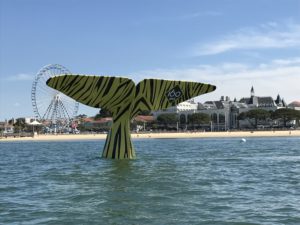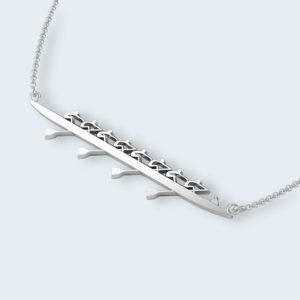The second in our series of “Super Exercises” for rowing and sculling.
Slide Progression Front-Stops (Reverse Pick Drill)
What is the exercise for?
Teaching the correct movement into the catch, the placement of the blade, the change of direction, the beginning of the power phase and correct drive sequence. Emphasis is on posture to ensure a strong connection from the leg drive through to the oar handle. This exercise is also known as the ‘Reverse Pick Drill’.
This exercise can be used to improve many areas such as:
- Preparing the body to take the catch (posture)
- Catch timing (correcting the ‘rowing the blade in’ problem)
- Control into front-stops
- Blade depth
- Timing of blade entry to the water of a crew at the catch
- Timing the leg drive within a crew
How the rower does the exercise…
There are four stages to this drill.
Stage 1 – Sit at front-stops with blades square in the water. Tap the hands down to fully remove the blades from the water then lift to fully cover them again. Continue these taps to get a feel for the weight in the hands and to develop a rhythm for the rest of the exercise.
Stage 2 – Take the first two inches of the stroke (known as a ‘grip’). When the blade is covered drive the legs for just two inches of slide before tapping down to remove the blade from the water. Slide forward to the catch position and repeat the two-inch stroke in a continuous movement.
Stage 3 – Extend the length of the stroke to half of the slide (or ‘half drive’).
Stage 4 – Extend the length of the stroke to three-quarters of the slide (or ‘three-quarter drive’).
This drill is best done with square blades to ensure clean extraction from the water.
It is best done with light to normal pressure so the rowers get a feel for gripping the water and not over-working the blade at the catch. They should feel the Placement, Connection and Drive as being three distinct elements.
There should be a large contrast between the speed of drive and the speed of recovery (ratio). Keep the movement into front-stops slow and controlled.
In crew boats the changes of length should be called over three strokes, as “Moving to Half-Drive. In 3… 2… 1… Go!” to avoid confusion over which stroke the change will be made on. This is especially important when moving from tapping to grips as there is so little time for the change of stroke. Explain to the coxswain to call the change at the FINISH because the crew needs time to make the change [most coxes call changes at the catch and there isn’t enough time in the short stroke for the whole crew to make the change].
For less experienced rowers working at the catch can be difficult. Starting the exercise with rowers sitting at three-quarter slide, instead of full reach, will help to improve stability and confidence. This should only be done for the first one or two repetitions and then the rowers should move out to front-stops to do the exercise again.
Pointers for the coach to check…
- Do the athletes start with good posture? This drill should be used to encourage rowers to sit tall with a straight back throughout the exercise. Forward body lean should come from the hips by rotation of the pelvis, stretching the hamstrings and not the back.
- Is body angle maintained throughout the stroke? The forward body lean which the rowers have coming into front-stops should be maintained through the catch and the drive phase in this exercise. The shoulder should be sternward of the hip joint. Encourage rowers to think about the connection and the drive being performed with the large leg muscles and not the upper body. Maintain the body angle and press it towards the bow by using the legs, keeping power low down on the footstretcher. Think of a ‘brace’ position, holding the ribcage high and strong.
- Are the athletes relaxed in the upper body? The upper body should be prepared to take the force from the legs and transfer it to the handle. This is best done with the upper body relaxed but supported by a strong core and trunk. Power comes from low down in the boat; the legs. Often athletes will tense their upper body and let the shoulders rise up. Tell them to think about keeping their shoulders low and wide, or as far away from their ears as possible.
- Do the athletes still have good posture after a few minutes? If not, take a break. This exercise is demanding for the core, trunk and hip muscles and under-developed athletes will start to slump as they get tired.
- Are athletes rushing into the catch? To get the correct sequence at the catch it is important to come into front-stops under control. Exaggerated slow slide speed should be used in this exercise to help the rowers feel the wheels rolling into the catch and best determine when to lift the hands to place the blade for the full length of stroke. Have the rowers think about getting weight onto the footplate before they slide forwards by having good posture and body lean. To control the slide think about sinking more and more weight low into the heels while sliding towards the stern.
- Does the bottom edge of the blade touch the water before the seat changes direction at the catch? The rowers should be starting to place the blade as the seat reaches its furthest point sternwards and the knees rise to their maximum height. If they are placing too late and ‘rowing it in’ do more work on tapping and grips (Stages 1 2). Try to get the rowers to think of the placement as the last part of the recovery. The hands lift with the last turn of the wheels, or with the last rise of the knees; the hands get to their highest point as the knees get to their highest point. With correct placement timing there should be a small amount of backsplash as the blade enters the water.
- Is the boat stable on the release? If not, make sure the rowers are getting to the same length in the drive and releasing together. Make sure they are keeping the load on the blade as late (long) as possible. Have the rowers slow down the change of direction from release to sliding, almost bringing a slight pause into the stroke.
- Are the athletes all making the same movements at the same time (crew boats)? If not, slow the movements down, especially the slide towards the catch. Do the exercise in pairs with the rest of the rowers sitting the boat to increase the load and allowing them to focus on just one other athlete.
- Is the blade depth correct? If not, go back to the tapping (Stage 1) and get the athletes to look at their spoons. The spoon should just be covered by the water when placed properly. Have the athletes note the amount they lift their hands to get this coverage. Progress through the exercise reminding the rowers of this height change. Ensure the upper-body is relaxed and rowers are not lifting their shoulders when placing or driving. Ensure the body angle is maintained during the leg drive so rowers are not lifting the blade during the drive. Use terms like ‘flat drive’ or ‘horizontal drive’.
Extensions of the drill and related exercises…
This exercise can be tailored to work on specific areas around the catch and early stages of the drive.
- Variations in Length: Extend the exercise to legs flat with the body still forward. Let the athletes keep their bodies forward and get a feel for when they need to bring the hips and body into the drive to maintain the force on the blade. Bring the bodies in so the athletes are rowing with straight arms. Have the athletes feel the full use of the hips and body and how they contribute to power through the end of the drive.
- Pauses: Pausing on the release helps to ensure the crew timing is correct during the drive. Pause at different stages of the slide (e.g. when doing half-drive try a pause at three-quarter slide) to get the crew moving through every part of the stroke together. During the pauses keep them thinking about being light on the seat (sitting weight at the front of the seat) and putting weight on the footplate.
- Add resistance: In larger boats have some of the crew sit the boat. In small boats add a bungee around the hull.
- Wide grip: Useful to relax the upper body and keep the legs as the driving muscles. In sculling: move both hands down the loom six inches. In sweep: move the inside hand down the loom six inches. Increase the width of the grip as the exercise continues
- Inside hand off (Sweep): Use only the outside hand during the exercise to feel the control of the oar and the connection between the feet and the outside hand.
Related exercises:
- Arms and Body Rowing – to work on the full drive sequence and set up good posture and sequencing from back-stops.
- Both the Episode 3 and Episode 4 e-books of the Faster Masters series are great to take it further and they also include helpful videos. Check them out!







